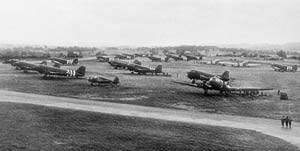The airport at Exeter had always been intended for use by the military in the event of war, and in 1939 the airport was taken over by the Air Ministry. Three asphalt runways were laid and RAF Station Exeter became officially operational on 6 July 1940.

RAF Hurricane squadrons had protected the Channel ports but in April 1944 the RAF units were withdrawn and the airfield was taken over by the US 9th Air Force. It became Station 463 and the United States 440th Troop Carrier Group, flying seventy C-47As and seventy CG-4 gliders, arrived in preparation for D-Day. There was insufficient hard standing so the group, comprising the 95th, 96th, 97th and 98th Squadrons, had to park many aircraft on the grass.
The battalion was on standby to depart on 4 June but bad weather in the Channel postponed the operation until 6 June. The invasion began in the early hours and the 440th Troop Carrier Group despatched 47 Dakotas, each carrying paratroops of the 101st Airborne Division.
After take off the four squadrons carrying 723 men and 2 platoons from C/326th Airborne Engineers also of the 101st Airborne, headed for the assembly area at Portland. In poor weather they then joined aircraft from other southern airfields for the journey across the Channel. Around 13,100 paratroopers of the U.S. 82nd Airborne and 101st Airborne Divisions made night parachute drops early on D-Day, followed by 3,937 glider troops flown in by day.
The unit lost three C-47s dropping the paratroopers over Carentan in the early morning of 6 June. On the next day they continued flying parapacks, fuel and ammunition to the landing area of Normandy, losing two more aircraft, for which they received the Distinguished Unit Commendation. They lost a third aircraft that day, when it was hit by a stray bomb from a higher flying P47 Thunderbolt.
The American airborne landings in Normandy were the first United States combat operations during Operation Overlord, the invasion of Normandy by the Western Allies.
Both divisions were part of the U.S. VII Corps and provided it support in its mission of capturing Cherbourg as soon as possible to provide the Allies with a port of supply. The specific missions of the airborne divisions were to block approaches into the vicinity of the amphibious landing at Utah Beach, to capture causeway exits off the beaches, and to establish crossings over the Douve River at Carentan to assist the U.S. V Corps in merging the two American beachheads.
After the cessation of hostilities in Europe, in May 1945, a succession of RAF squadrons arrived and departed the airfield until October 1946. Exeter Airport was handed over to the Ministry of Civil Aviation in January 1946.


